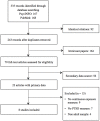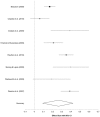Measuring exposure in Hurricane Katrina: a meta-analysis and an integrative data analysis
- PMID: 24713851
- PMCID: PMC3979656
- DOI: 10.1371/journal.pone.0092899
Measuring exposure in Hurricane Katrina: a meta-analysis and an integrative data analysis
Abstract
To date there is no consensus on the operationalization of exposure severity in the study of the impact of natural disasters. This is problematic because incomplete and inconsistent measurement of exposure limits the internal and external validity of disaster studies. The current paper examined the predictive validity of severity measures in two interrelated studies of Hurricane Katrina survivors. First, in a meta-analysis of eight studies that measured both exposure severity and posttraumatic stress, the effect size was estimated to be r = .266. The moderating effects of sample and study characteristics were examined and we found that minority status and number of stressors assessed were significant moderators. Second, in an integrative data analysis of five independent samples of Hurricane Katrina survivors, the impact of specific disaster-related stressors on mental health was compared. Threat to physical integrity of self and others were found to have the strongest association with posttraumatic stress (PTS) and general psychological distress (GPD). The lack of basic necessities, such as food, water, and medical care, and loss of pet were also found to be strongly associated with both PTS and GPD. The results from the two studies are integrated and their implication for disaster research and relief are discussed.
Conflict of interest statement
Figures
References
-
- Neria Y, Galea S, Norris FH, editors. (2009) Mental health and disasters. New York: Cambridge University Press. 642 p.
-
- Norris FH, Friedman MJ, Watson PJ, Byrne CM, Diaz E, et al. (2002) 60,000 disaster victims speak: Part I. An empirical review of the empirical literature, 1981–2001. Psychiatr 65 (3) 207–239. - PubMed
-
- Rubonis A, Bickman L (1991) Psychological impairment in the wake of disaster: The disaster-psychopathology relationship. Psychol Bull 109 (3) 384–399. - PubMed
-
- Galea S, Nandi A, Vlahov D (2005) The epidemiology of post-traumatic stress disorder after disasters. Epidemiol Rev 27 (1) 78–91. - PubMed
-
- Green B (1991) Evaluating the effects of disasters. Psychol Assessment 3 (4) 538–546.
Publication types
MeSH terms
LinkOut - more resources
Full Text Sources
Other Literature Sources
Medical





